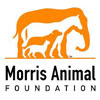Glossary of Terms
Alleles
The exact same or slightly different alternative forms of a gene, one inherited from each parent.
Autosomal Dominant Disease
When inheritance of only one mutant allele on any non-X or non-Y chromosome
results in a disease
Bilateral
On both sides. Bilateral hip dysplasia is hip dysplasia which
affects both hip sockets.
Cardiologist
A veterinarian with extensive training in cardiology. A cardiologist will
have training and experience that will lead to inclusion in the American
College of Veterinary Cardiologists.
D-ACVR
Diplomate—American College of Veterinary Radiologists. Diplomate
status indicates further advanced training and experience in a specific
field. In this case, the individual has completed training and has passed
examinations to have diplomate status as a veterinary radiologist.
Degree of Luxation
Luxation is a term indicating that a joint is abnormally out of position.
In a normal joint, the pieces that articulate (fit together) have a predefined
way of fitting together. Luxated joints have not maintained this fit.
Degree of luxation is the amount of change away from this normal position.
DNA (deoxyribonucleic acid)
The genetic material of living organisms, transmitted from generation
to generation, which specifies the characteristics an offspring inherits
from its parents.
DNA Profile
Also known as a DNA "fingerprint;" a composite of a set of approximately
a dozen highly polymorphic genetic markers that characterizes the individual
uniquely.
Dominant
When the presence of only one copy of a particular gene results in the
inheritance of an observable trait or disease.
DVM
Doctor of Veterinary Medicine. A graduate degree requiring 4 years of
training in veterinary medicine. This training includes clinical skill
development.
Genes
The biochemical sequences of DNA that constitute the functional units
of heredity that are transmitted from generation to generation, and which
are ultimately translated into proteins that carry out specific structural
or enzymatic functions.
Genotype
An individual's unique assortment of genes inherited from both parents.
It is characterized by a marker or a banding pattern at a particular locus.
Heterozygous
Two genes in the same location that are unlike in action (Aa).
Dominant traits may be expressed in the heterozygous state.
Homozygous
Two identical genes (a matched pair) in the same location for
the same trait (AA).
Mendelian Inheritance
The pattern of gene inheritance originally described by Gregor Mendel;
the inheritance of one copy of a gene (allele) from each parent by its
offspring.
Monogenic
Coming from one ("mono") gene pair.
MS
Master of Science. This degree indicates the individual has completed
an advanced curriculum in a specific area of study. Most Master's programs
include course work and research.
Palpation
Manipulation of a joint.
Phenotype
The outward production of the genotype, combined with environmental influences.
Polygenic
Coming from more than one ("poly") gene pair. These traits are
more complex than the typical dominant or recessive genetic trait. The
additive interaction of the genes can cause variable results and the gene
can be easily passed on to other generations without being identified.
Recessive
Two identical alleles at a locus producing a particular characteristic,
trait, or disease.
Specialist
A veterinarian with training in a given area that also includes postgraduate
work in cardiology. For instance, and internal medicine specialist will
also be trained in cardiology.
Spondylosis
Smooth new bone production between vertebral bodies at the
intervertebral disc spaces. The new bone production can vary in extent
from formation of small bone spurs to complete bridging of adjacent vertebral
bodies. Spondylosis may occur secondary to spinal instability but often
it is of unknown cause and clinically insignificant. A familial basis
for its development has been reported.
Transitional
Vertebrae
A congenital malformation of the spine that occur at the junctions of
major divisions of the spine (usually between the thoracic and lumbar
vertebral junction and the lumbar and sacral vertebral junction). Transitional
vertebrae take on anatomic characteristics of both divisions of the spine
it occurs between. The most common type of transitional vertebrae in dogs
is in the lumbo-sacral area where the last lumbar vertebral body takes
on anatomic characteristics of the sacrum.
Unilateral dysplasia
One side only. Dysplasia may be found in both hip joints (bilateral) or
in one hip joint only (unilateral).




